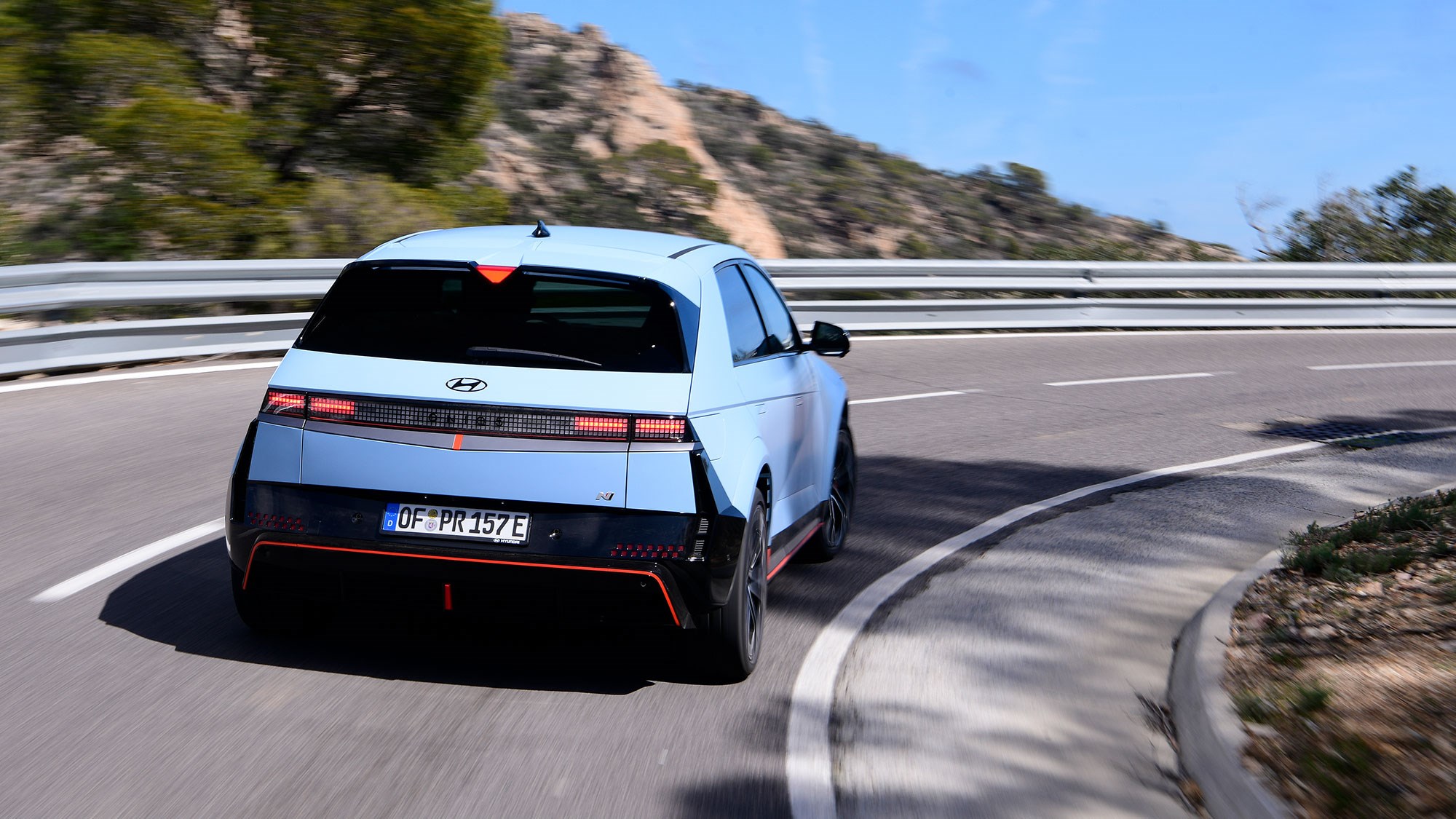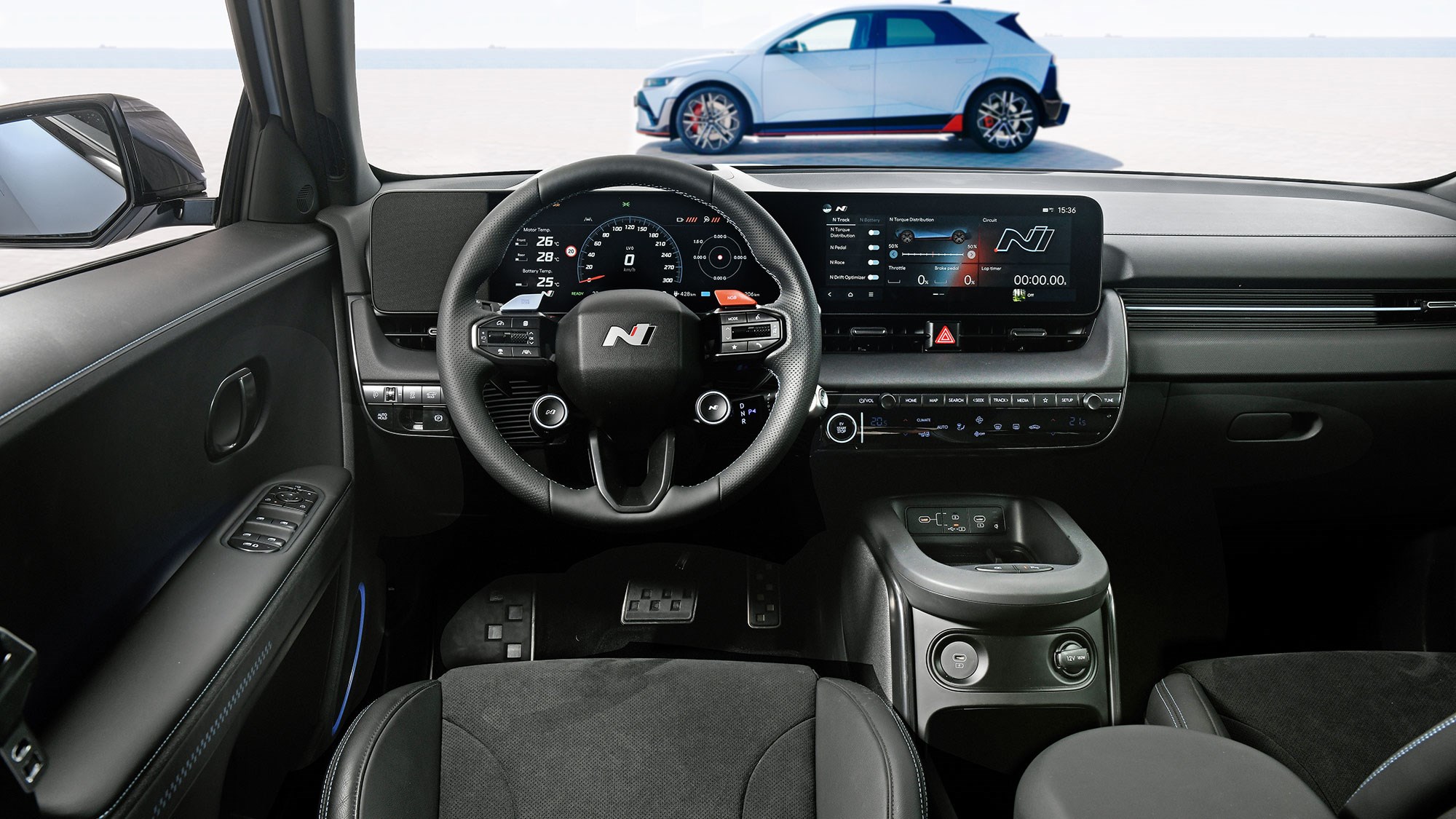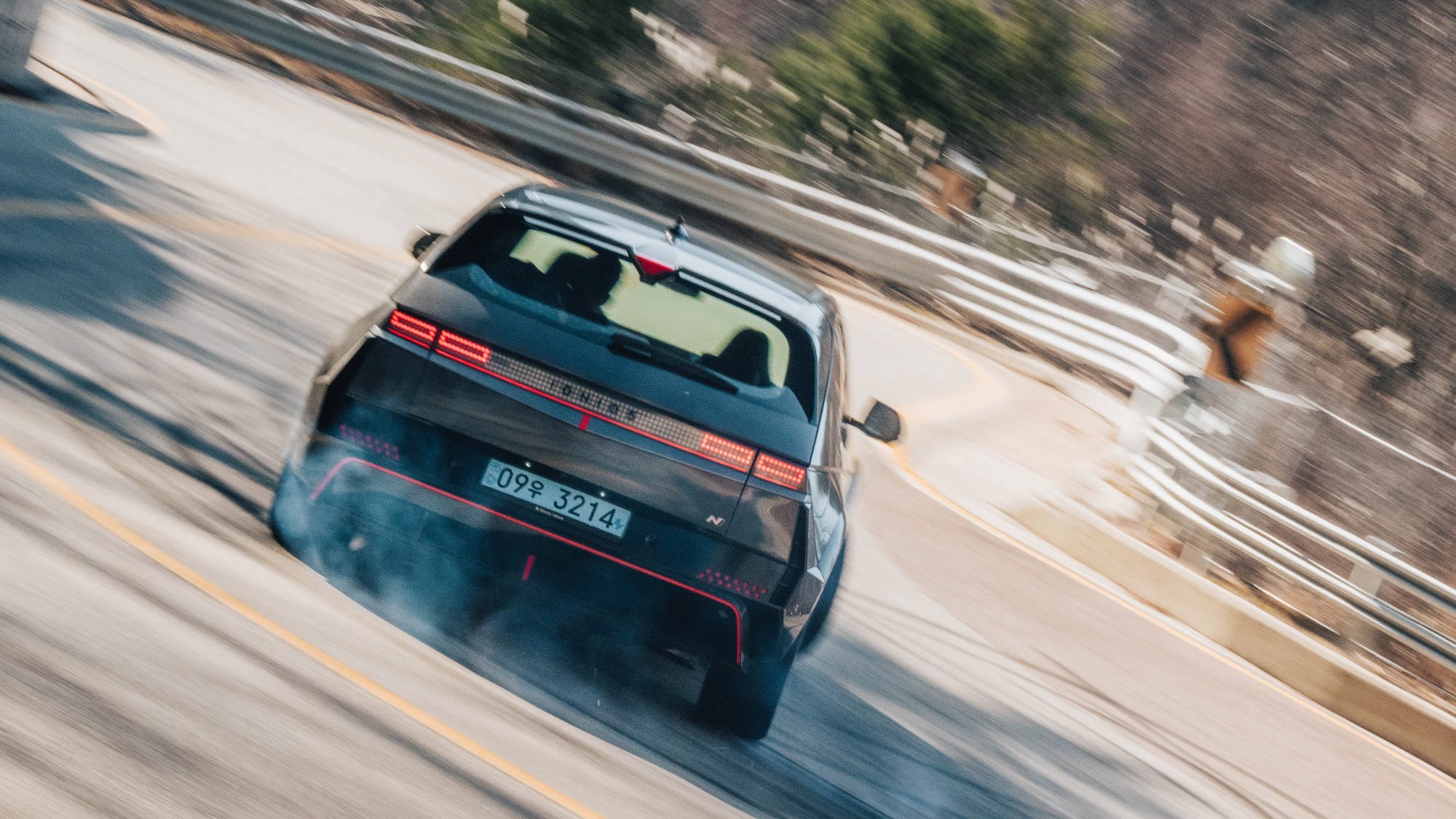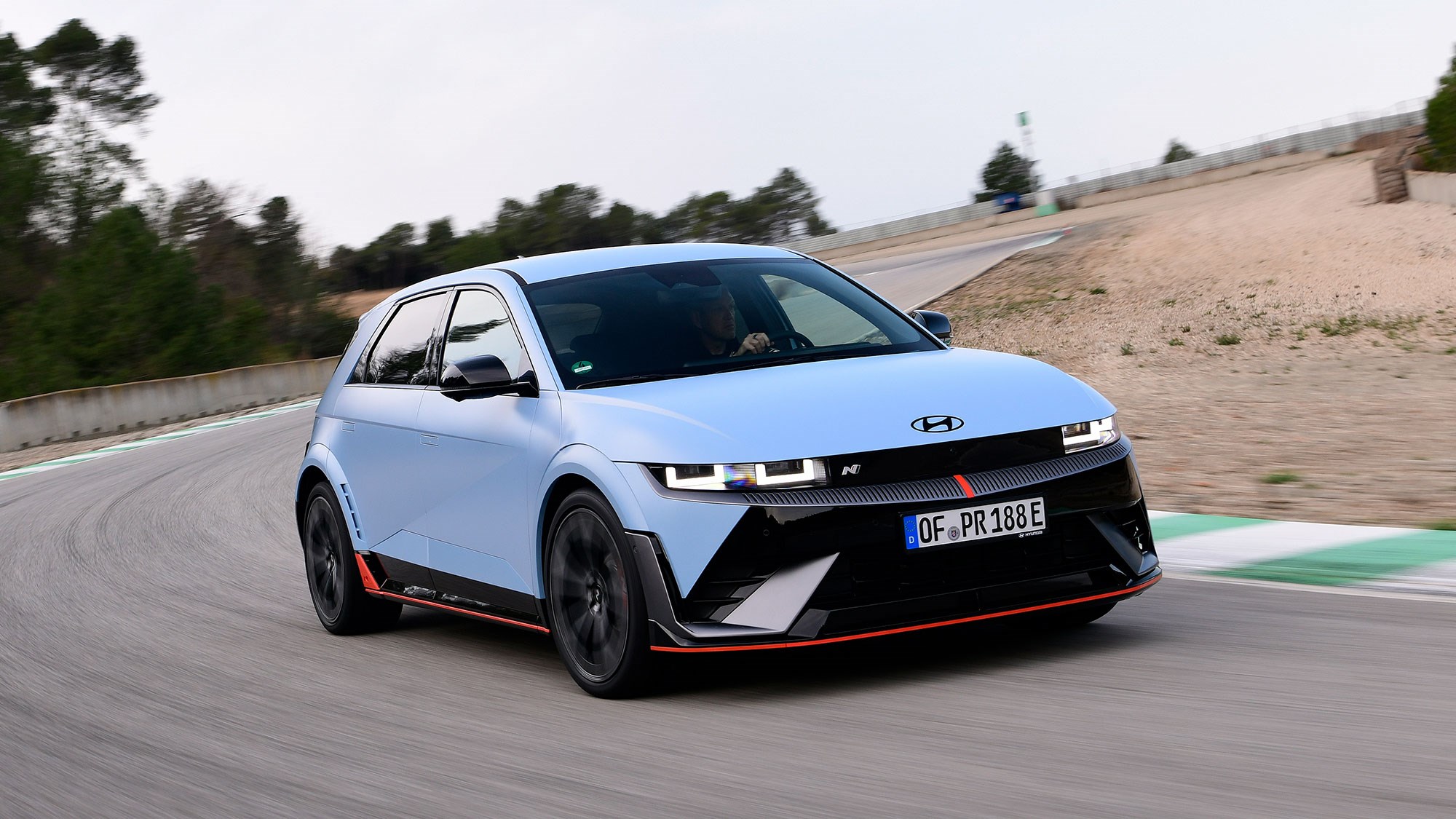► Hyundai Ioniq 5 N video review
► 641bhp, 0-62mph in 3.4 sec
► Electric hot hatch costs £65k
The Hyundai Ioniq 5 N is the next chapter in a book of surprises that stretches all the way back to the introduction of the i30 N. Hyundai’s N division has fought hard to establish itself in the hot hatchback market, squaring up against time-served rivals such as the Volkswagen Golf GTI and the Ford Fiesta ST. Against all odds, though, it often came out on top.
But Hyundai is facing its toughest challenge yet, because it’s just axed its world-beating petrol-powered hot hatchbacks in favour of this new pure electric alternative. That’s a huge gamble for the firm, because it’s risking alienating its loyal enthusiast fanbase to save the planet. It’s a commendably altruistic strategy but, on the surface at least, it doesn’t seem like the most sensible business decision.

Hyundai is confident the Ioniq 5 N will appeal to petrolheads, though. It’s a 641bhp, £65k hyper-hatch that promises to do things that no other electric performance car has done before. It’s peppered with features that designed to appeal to old school driving enthusiasts, such as some synthetic engine noise, a simulated dual-clutch gearbox and an incredibly talkative chassis setup.
It’s been beautifully executed – and it’s good enough to make even our most devout petrolhead staffers feel optimistic about the future of electric performance cars. Scroll down to find out why.
What’s different?
Lots. Starting with some mighty impressive top-line stats. The Ioniq 5 N’s two electric motors have a combined output of 641bhp and 546lb ft of torque. That’s enough for a 0–62mph of just 3.4 seconds and a top speed of 162mph. Or, in other words, this Hyundai is a second quicker to 62mph than a Volkswagen Golf R – and 7mph faster going flat out.
To cope with all this extra poke, Hyundai combed through the Ioniq 5’s chassis fitting beefier dampers, tougher front and rear subframes, stiffer battery and motor mounts, bigger brakes and a completely new steering rack that’s faster from lock to lock. Oh yeah, and the body is stitched together with an additional 42 welds and 2.1 metres of structural adhesive so it won’t tear itself apart on a racetrack.
Battery capacity is quoted at 84kWh (compared to 77.4kWh in the standard car), and you get DC rapid charging speeds of up to 350kW. That means a 10 to 80% charge should be conquered in around 18 minutes. Hyundai also reckons the N can go 278 miles between trips to plug, although that figure depends entirely on how heavy your right foot is.

You’ve probably noticed the styling changes, too. The massive rear diffuser and sticky-out chin spoiler make the N 80mm longer than a regular Ioniq 5. It’s also 20mm lower and 50mm wider to make space for some girthier tyres (275/35 21-inch Pirelli P-Zeros).
But those vents, wings and louvres are much more than a designer’s passion project. They’re mostly functional, channelling air around the body to cool the brakes and the battery pack, as well as helping to keep the car glued to the road when you’re pedalling it hard.
Upgrades to the cabin are comparatively minor. You get a pair of Hyundai N seats positioned 20mm lower, a very round Alcantara-clad steering wheel and a new centre console with knee pads to give you something to brace yourself against on the track. There are also a few extra buttons to play with…
What do the N driving modes do?
Pretty much anything you like. There are of course three regular presets – Eco, Normal and Sport – but the latter seems largely pointless when there’s a vast array of settings to be accessed in the N modes. Each one is selected via a button on the steering wheel, in much the same was as BMW’s M1 and M2 drive modes on its spiciest performance cars.
Once you find the N menu on the infotainment screen, you can customise the experience to your heart’s content. Here, you can tweak the settings of the electric motors, steering weight, damper stiffness, electronic limited-slip differential and more. The i30N had more than 1900 drive mode combinations and the Ioniq 5 N without doubt offers many, many more.

Hyundai’s N e-Shift function is worth a special mention. This turns the paddles behind the wheel – usually used to adjust regen settings on EVs – into ‘gearshift’ paddles that rattle through a simulated eight-speed DCT transmission. Hyundai even wired in a simulated rev limiter that the car will crash into should you leave the upshift too late. Amusingly, it’s been set at 6700 rpm on the digital dashboard but could, of course, have been placed at any number.
N Active Sound+, meanwhile, simulates engine noise in the 5 N’s cabin with a choice of three different settings. Ignition delivers a traditional (and incredibly amusing) ICE soundtrack, Evolution offers up a futuristic EV whine and Supersonic is supposed to mimic a fighter jet. Why? Well, the engineers responsible for the car’s soundtrack were big fans of Top Gun Maverick and they thought it would be amusing to shoehorn the noise into their Active Sound+ tech.
As for the Evolution setting, it’s a copy of the noise made by the fictional Hyundai N 2025 Vision Concept that features in the Gran Turismo video game. That means that a real car has copied the soundtrack of one from the virtual world. We’re living in the future, folks.

N Torque Distribution is the next feature to grab our attention as it allows the driver to switch the car from being entirely front-wheel drive, to fully rear-wheel drive or any of the nine settings in between. We’ve seen ICE cars flirt with this sort of thing before (the Mercedes-AMG E63 S could shut off torque to the front wheels in its Drift Mode for example), but nothing that offers this level of choice. Simply put, this is a feature that is only possible in an EV.
Speaking of drift modes, the Ioniq 5 N has its own. Labelled N Drift Optimiser, it does exactly what it says on the tin and primes the car for optimum sideways action. It’s even got a built-in clutch-kick (or as Hyundai calls it, Torque Kick Drift) that, when you pull back both steering wheel paddles, suspends the power and then re-engages it with a thump when you release. Nice idea, but it requires the driver to have hands at nine and three in order to activate – not ideal when you’re about to apply armfuls of corrective lock (see below).
Finally, the N Pedal setting is perhaps the most intriguing as it exaggerates a piece of tech that’s featured on EVs for years. Select this mode and the notion of one-pedal driving is taken to extremes, with any lift off the throttle delivering significant (up to 0.6G) regen braking. That’s enough to shift the weight over the nose and create an incredibly pointy front end.

It’s counter-intuitive at first and takes some getting used to but, after a while, the rhythm builds up and it feels surprisingly natural. Indeed, we’re told that Tyrone Johnson – Hyundai’s Director of Vehicle Development and the man previously behind the Ford Focus RS – rates it as one of his favourite features on the car. We’re hard pressed to disagree with him.
Finally, N Grin Boost (yes, that’s really what they called it…), gets its own button on the steering wheel. It’s basically the EV equivalent of the ‘Go Baby Go’ button on the Gone In 60 Seconds Mustang. Press it and you get 10 seconds of 641bhp lunacy for optimum straight-line performance. Otherwise, the motors only produce a piddling 601bhp.
Also worth noting are the N Launch Control (no prizes for guessing what that does), N battery pre-conditioning (primes the battery temperature for a drag race or sustained hot-laps) and N Race (metes out the battery capacity for either a short burst of activity or continuous laps) – all of which help make the most of the available juice.
How does it drive?
This is the most important question because, while we know performance EVs are always devastatingly quick in a straight line, they tend to fall short on driver engagement when compared to their petrol rivals. We’re in no doubt that the Ioniq 5 N has a sense of humour (the N Grin Boost button tells you all you need to know about that), but does it do enough to seize the attention of its driver?
In short – yes. And it does it mind-blowingly well. After just half an hour of driving, I was convinced that this was the most fun I’d ever had behind the wheel of an EV. After a further two days behind the wheel, nothing had changed my mind.

Let’s start with the mechanical feel of the thing – the bit that the gadgets and gizmos can only do so much to influence. Strip everything back and this is a seriously well sorted car. It reminds me of a Ford Focus RS in the way that the front end is fast, positive and poised, while the e-LSD enabled rear is always looking to rotate the car as much as possible.
The fettled power steering also delivers impressive feel and positivity through the Alcantara-trimmed wheel. Carving a line into a corner isn’t a guessing game of micro-movements – it gives you plenty of confidence to make one swift movement in and tickle at the lock if you need to correct a slide. Okay, it’s a long way from delivering Lotus Elise levels of feel, but it’s incredibly impressive for a 2.2-tonne EV.

Clearly, there’s a hugely sorted chassis underneath the boxy bodyshell, but the gadgets and gizmos also deserve praise. Hyundai’s N e-Shift function has solved perhaps the biggest issue we have with driving EVs quickly – a completely warped sense of speed. By serving up the N’s performance in familiar (and near-perfectly mimicked) chunks, it helps you pace yourself around a track. It also adds a further welcome dash of engagement.
The car’s weight is perhaps the only sticking point we encountered. It’s just 100kg lighter than a Range Rover for crying out loud, which means its tyres will scream for mercy far sooner than they would if they were yoked to a traditional super hatch such as an Audi RS 3 or Mercedes-AMG A 45 S. If you’re planning on using the car for track work (which Hyundai’s engineers were all too keen to recommend), we suggest you set aside a healthy budget for replacement rubber.
Verdict
This is our second time driving the Ioniq 5 N. We’d moved from the immaculately manicured roads of South Korea to the immaculately manicured roads of Spain – so we’ll withhold our verdict on the car’s ride until we’ve driven it on Blighty’s battered road network.
We’re certain about our opinion on the car’s driving experience, though. This is the most fun you can have at the wheel of an electric car. We love everything about it – it’s blisteringly quick in a straight line, enchantingly engaging in the corners and packed with clever technology that’s specifically designed to appeal to Hyundai’s slightly nerdy petrolhead fanbase.
It’s not like a hot hatchback of 20 years ago – and nor should we expect it to be. But, if this is the blueprint for where performance are going as we delve into the electric era, it’s hugely encouraging. Hyundai deserves serious credit for making it happen.
It’s hard to believe that Hyundai only built its first hot hatch in 2017. Six years later, it’s gone and delivered the benchmark EV version.
Photography by Albus Studios